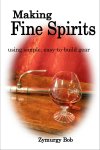Zymurgy Bob's Distillation Facts
The Basics of Distillation

Distilling at its simplest is shown in the figure below.

Heat, fire in this example, is applied to the boiler, which contains an alcoholic wash, some mixture of ethanol (drinking alcohol), water, and frequently other substances, both solids and liquids. Usually this is created by the action of yeast on sugars, a process called fermentation.
When the wash is heated to boiling, some of the wash becomes vapor, which expands and leaves the boiler by way of the lyne arm. When the vapor travels through the lyne arm it comes to the condenser, which is cooled by some external means, often by circulating cooling water.
When the vapor is cooled, it condenses back to a liquid, called the condensate, which is then collected as distillate.
While this illustration is greatly simplified for instruction, it is also a pretty accurate description of a potstill, the oldest and potentially simplest type of liquor still. Although the potstill's design is ancient, many of the world's finest liquors, including Cognac, arguably the best bourbons, and that 30-year-old single malt you may covet, are still made on potstills very much like my example.

